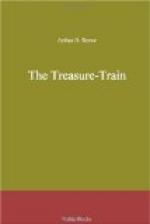Cranston wrote hastily on the back of one of his cards what Kennedy dictated.
Please allow Doctor Kennedy to make a psychanalysis
of my
wife’s mental condition.
“You will let me know—if there is—any hope?” he asked.
“As soon as I can,” replied Kennedy, “I’ll let you have a copy of my report.”
Cranston thanked us and bowed us to the door suavely.
“Well,” I remarked, as we rode down in the elevator, “that was clever. He fell for it, too. You’re an artist. Do you think he was posing?”
Kennedy shrugged his shoulders.
We lost no time in getting the first train for Montrose,
before
Cranston had time to reconsider and call up Doctor
Burr.
The Belleclaire Sanatorium was on the outskirts of the town. It was an old stone house, rather dingy, and surrounded by a high stone wall surmounted by sharp pickets.
Dr. Bolton Burr, who was at the head of the institution, met us in the plainly furnished reception-room which also served as his office. Through a window we could see some of the patients walking or sitting about on a small stretch of scraggly grass between the house and the wall.
Doctor Burr was a tall and commanding-looking man with a Vandyke beard, and one would instinctively have picked him out anywhere as a physician.
“I believe you have a patient here—Mrs. Roger Cranston,” began Kennedy, after the usual formalities. Doctor Burr eyed us askance. “I’ve been asked by Mr. Cranston to make an examination of his wife,” pursued Craig, presenting the card which he had obtained from Roger Cranston.
“H’m!” mused Doctor Burr, looking quickly from the card to Kennedy with a searching glance.
“I wish you would tell me something of the case before I see her,” went on Kennedy, with absolute assurance.
“Well,” temporized Doctor Burr, twirling the card, “Mrs. Cranston came to me after the death of her child. She was in a terrible state. But we are slowly building up her shattered nerves by plain, simple living and a tonic.”
“Was she committed by her husband?” queried Kennedy, unexpectedly.
Whether or not Doctor Burr felt suspicious of us I could not tell. But he seemed eager to justify himself.
“I have the papers committing her to my care,” he said, rising and opening a safe in the corner.
He laid before us a document in which appeared the names of Roger Cranston and Julia Giles.
“Who is this Julia Giles?” asked Kennedy, after he had read the document.
“One of our nurses,” returned the doctor. “She has had Mrs. Cranston under observation ever since she arrived.”
“I should like to see both Miss Giles and Mrs. Cranston,” insisted Kennedy. “It is not that Mr. Cranston is in any way dissatisfied with your treatment, but he thought that perhaps I might be of some assistance to you.”
Kennedy’s manner was ingratiating but firm, and he hurried on, lest it should occur to Doctor Burr to call up Cranston. The doctor, still twirling the card, finally led us through the wide central hall and up an old-fashioned winding staircase to a large room on the second floor.




